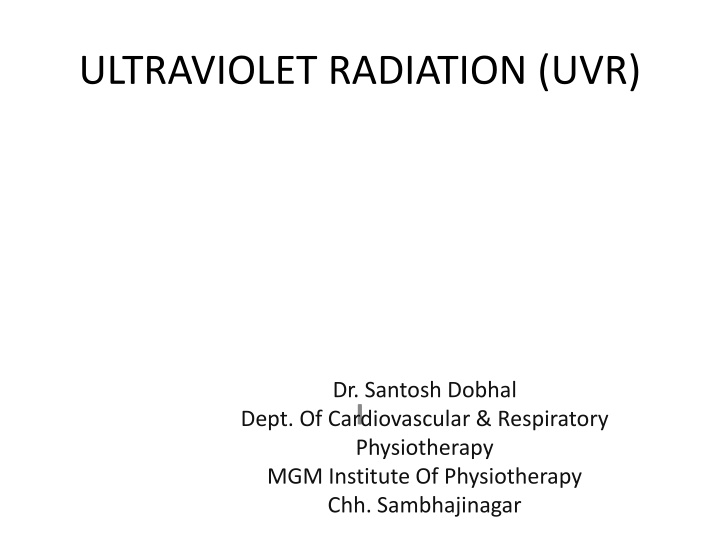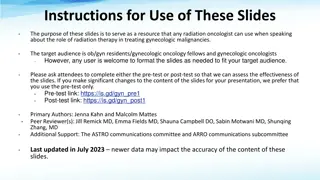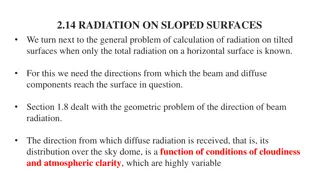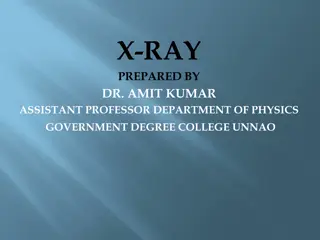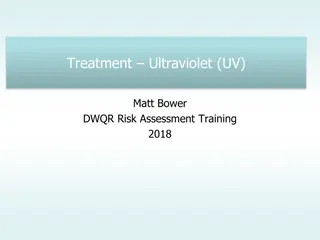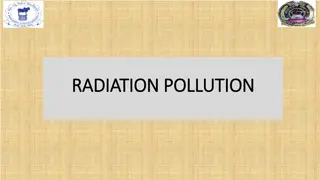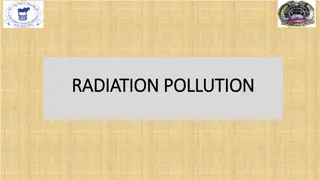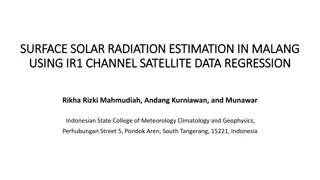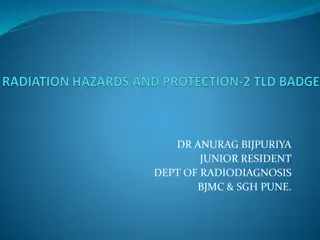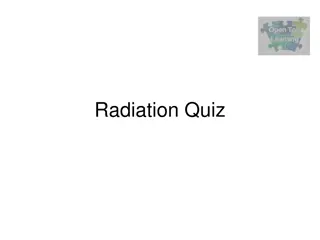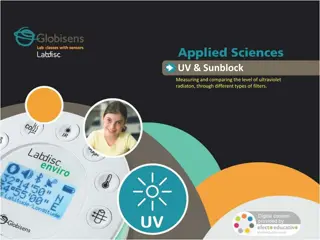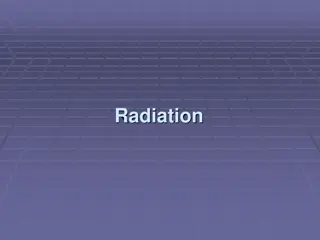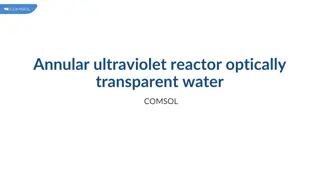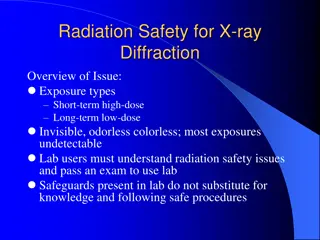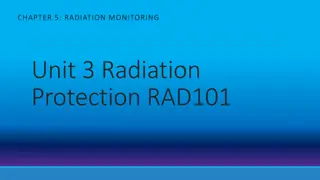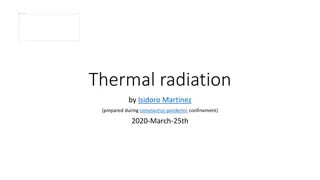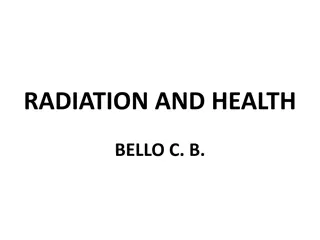ULTRAVIOLET RADIATION (UVR)
Ultraviolet Radiation (UVR) is part of the electromagnetic spectrum, invisible to the human eye. It has various types such as UVA, UVB, and UVC, each with different effects on the skin. Exposure to UVR can lead to sunburn, tanning, skin cancer, and other health issues. Learn more about UVR and its impacts on the body.
Download Presentation

Please find below an Image/Link to download the presentation.
The content on the website is provided AS IS for your information and personal use only. It may not be sold, licensed, or shared on other websites without obtaining consent from the author.If you encounter any issues during the download, it is possible that the publisher has removed the file from their server.
You are allowed to download the files provided on this website for personal or commercial use, subject to the condition that they are used lawfully. All files are the property of their respective owners.
The content on the website is provided AS IS for your information and personal use only. It may not be sold, licensed, or shared on other websites without obtaining consent from the author.
E N D
Presentation Transcript
ULTRAVIOLET RADIATION (UVR) Dr. Santosh Dobhal Dept. Of Cardiovascular & Respiratory I Physiotherapy MGM Institute Of Physiotherapy Chh. Sambhajinagar
INTRODUCTION Ultraviolet radiation (UVR) covers a small part of electromagnetic spectrum lying between the violet end of the VISIBLE LIGHT and X-RAY REGION.
Introduction UVR are INVISIBLE to the human eyes. Natural source of UVR is SUN. UVR provoke CHEMICAL CHANGES & not simply heat at sites where they are absorbed.
Introduction The radiations introduced to the tissues through 1.subcutaneous tissue, 2.hair follicles, and 3.sebaceous glands.
Types of UVR 1. UVA (Long UV) 400 315nm. {penetrates to dermis, Responsible for development of slow natural tan} 2. UVB (medium UV, erythemal UV) 315 280nm. {Produces new pigment formation, sunburn, Vitamin D synthesis. Responsible for inducing skin cancer} 3. UVC (short UV, germicidal UV) 280 100nm {Does not reach the surface of the earth}
Generalized response to UVR Exposure 1. Sunburn (UVB) / Erythema ( Reddening of the skin) 2. Tanning of the skin / Pigmentation 3. Decrease in sensitivity of the skin (Increased Epidermal thickness) 4. Premature aging of the skin (UVA) 5. Skin cancer (UVB) 6. Exposure to the eye causes photokeratitis (UVB) 7. Photosynthesis of vitamin D
The physical Behavior of UVR 1. Reflection 2. Refraction 3. Absorption 4. Penetration
UVR Generators 1. High pressure mercury vapor lamp Air cooled. 2. High pressure mercury vapor lamp Water cooled ( Kromayer lamp). 3. Fluorescent lamps
PENETRATION OF THE Uv rays UVA Dermis level. UVB Deep Epidermis
Physiological effects of UVR The UVR physiological effects may be divided into 2 groups; 1.Local Effects which produced locally in the area. 2.General Results from a widespread Irradiation.
Local effects of uvr 1. ERYTHEMA It is reddening of the skin. First observable effect of UV Irradiation. It cause chemical action which result in IRRITATION & DESTRUCTION of cells. This causes liberation of H -substance which RESPONSE. The erythema is regarded as an inflammatory reaction stimulated by the UVR. produce the TRIPLE
TRIPLE RESPONSE 1. Dilation of capillaries H-substance 2. Dilation of arterioles Axon reflex 3. Exudation of fluids into the tissues Increased permeability of the capillary walls.
2. Pigmentation / tanning It is thought that the UVR stimulates MELANOCYTE & ACCELERATES the production of MELANIN PIGMENT. Pigmentation commonly follows an erythemal reaction. It varies with the dosage of UVR & the different individuals.
2. Pigmentation / tanning Sometimes immediate tanning occurs as a result of effects of PRE-EXISTING melanin. This may occur within minutes of exposure. Sun / Carbon arc Brown color Mercury Vapor lamp Grayish The pigmentation REDUCES the penetration of UVB.
3. Thickening of epidermis UVR provokes an increased reproduction of KERATINOCYTES. This leads to thickening of epidermis which acts does acts a PROTECTION AGAINST THE RAYS. So longer doses are required to repeat an ERYTHEMAL reaction.
4. Desquamation / peeling It is the CASTING OFF of dead cells from the surface of the skin. The desquamation is proportional to the intensity of the erythema. The peeling results in REDUCTION / LOSS OF THE INCREASED RESISTANCE TO THE RAYS.
5. Antibiotic effect Destructive effects of ultraviolet radiation include the destruction of viruses, bacteria, and other small organisms on the skin surface such as FUNGI commonly found in wounds. (effect of UVB).
B. General effects of UVR 1. Vitamin D Production In the presence of UVB, converts 7- Dehydrocholestrol into Vitamin D through chemical reaction. Vitamin D is required to assist in the absorption of calcium and phosphorous from the intestine to blood stream.
2- The Esophylactic effect General UVA Irradiation Stimulation of reticulo - endothelial system Ingest bacteria & produce ANTIBODIES against BACTERIA & TOXINS. So the resistance of the body to infection is increased & this being known as ESOPHYLACTIC EFFECT.
3. GENERAL TONIC EFECT Its being claimed that because of General UV Irradiation has a GENERAL TONIC EFFECT, APPETITIE & SLEEP BEING IMPROVED NERVOUSNESS & IRRITABILITY DECREASED
Therapeutic effects of uvr The principle therapeutic uses of UVR are of SKIN DISEASES 1. PSORIASIS:- It is a skin condition which presents localized THICK PINK / RED plaques, sharply demarcated & covered with SILVERY SCALES. In this state the aim of UVR irradiation is to decrease the DNA synthesis in the cells of the skin & to improve the skin condition
2. Acne vulgaris Acne is also a skin condition which presents PUSTULES, PAPULES formed by blocking of sebaceous pores & hair follicles affecting mainly the face, chest & back. The more severe & long lasting forms cause disfiguring & serious distress. Using UVR is aiming to produce desquamation to open the blocked pores and hair follicles. E2 dose is given to the face, chest and neck.
3. eczema It is an INFLAMMATORY RESPONSE in the skin associated with OEDEMA. The patient suffers marked ITCHING with REDNESS, SCALING, VESCILES & exudation of serum on the skin. A mild UVR treatment will help. (Sub acute & Chronic stage)
4. Chronic infection & infected wounds Infected wounds such as 1. ULCERS 2. PRESSURE SORES 3. SURGICAL INCISIONS are often treated with HIGH DOSES of UVR. The aim of UVR irradiation is to destroy the surface bacteria, remove the (SLOUGH) infected material & promote repair. E3 dose is sufficient, the dose is may be given daily and is not being applied to normal skin.
5. VITILIGO It is a condition in which destruction of MELANOCYTES in local areas causes WHITE PATCHES to appear on the skin. Both UVA & UVB stimulate melanocyte activity. UVA seems to provoke a DARKER & LONGER LASTING TANNING. UVB provokes more THICKENNING.
6. NON INFECTED WOUNDS The aim of UVR is to stimulate the GROWTH of GRANULATION TISSUE & SPEED UP REPAIR. UVA stimulates GROWTH. Example for non infected wounds are Venous / Arterial ulcers.
7. Counter irritation It is used to produce a strong counter irritation effect over the site of DEEP SEATED PAIN. E4 dose is given to cause discomfort and producing mask of pain .
INDICATIONS FOR UVR 1. DERMATOLOGICAL CONDITIONS Psoriasis, Acne, Sub acute & Chronic Eczema. 2. Calcium / Phosphorus disease Osteomalacia 3. Non pulmonary tuberculosis 4. Local Ulceration Ulcers, Pressure sores, Surgical incision
INDICATIONS FOR UVR 5. Upper respiratory condition management Common Cold. 6. Counter Irritant Effect.
Contraindication of uvr 1. Pulmonary Tuberculosis 2. Severe cardiac disturbances 3. Systemic Lupus Erythematosis 4. Severe Diabetes 5. Dermatological Conditions
Contraindication of uvr 6. Known Photosensitivity. 7. Photosensitizing medication. 8. Deep x Ray therapy. 9. Acute Febrile illness 10. Recent skin grafts.
Contraindication of uvr Porphyrias Hyperthyroidism Generalized dermatitis Pellagra Advanced arteriosclerosis Sarcoidosis Acute eczema Xeroderma pigmentosum Herpes simplex Acute psoriasis Hypersensitivity to sunlight Renal and hepatic insufficiencies
dangers 1. Shock 2. Eyes - UVR may produce conjunctivitis, iritis or cataract. 3. Over Dosage UVR burn can occur. Mainly E4 reaction 4. Ozone Important to ensure adequate Ventilation in the area.
Safety precautions against sunlight(UVR) 1. Eyes protection. http://www.penseurope.com/images/product/ven_mb_kc5909_main.jpg
2. Skin damage / tanning protection Sunscreen doesn t offer 100% protection. SPF(Sun Protection Factor) 30+ sunscreen blocks 96% of UV; SPF 15+ blocks out 93%. In addition to sunscreen, wear a hat, sunglasses, more clothing, and seek shade.
Guidelines for Protection Tanning Protection Oklahoma State University
Protective clothing Most cotton and cotton/polyester fabrics protect against 95% of UV, but are less effective if wet, faded, or aged.
Test dose & determinig med It is used to assess the individual patients (ERYTHEMAL) reaction to uvr irradiation. The basis for any calculation of any UVR dosage is the MED (MINIMAL ERYTHEMAL DOSE) This MED refers to the response of erythema for the dose to be given
Test dose cont. The patient must understand that the purpose of the MED test is to DETERMINE just how much EXPOSURE TIME is necessary based on their skin sensitivity. Proper patient education should be given:- 1. Wear Goggles 2. Observe & monitor the skin condition 3. Keep skin moisture following exposure to UVR 4. Pigmentation changes are to be expected & are a normal response. 5. Prolonged & repeated exposure leads to premature aging.
steps to determine test dose / skin test 1. The area chosen for the test is of importance. 2. Because the patient is to inspect at regular intervals a convenient, visible site is essential. 3. It should be clear of skin disease. 4. The FLEXOR SURFACE of the FOREARM is the most usual site.(Other sites are Abdomen, Medial aspect of arm / thigh) 5. The selected site should be cleaned with soap & water to remove surface grease. 6. Cover the patient other areas leaving only the forearm exposed to UVR.
steps to determine test dose / skin test 7. Three to Five holes of at least 2cm & 1cm apart are cut in a piece of lint/paper/cardboard is taken for irradiation of UVR along with a slide cover to pull up to reveal one opening at a time.
steps to determine test dose / skin test 8. This cutting is fixed to the forearm with adhesive plaster. 9. The cuttings are of different sizes & shapes in-order to make IDENTIFICATION OF THE ERYTHEMA EASIER for the patient. 10. Allow the lamp to warm up according to the manufacturer instructions. 11. Place the lamp PERPENDICULAR to the area being tested (Forearm) & a DISTANCE of 60 to 90cms from the site. 12. Expose the 1st opening for 30sec, then expose the 2nd opening for another 30sec & go on till the last opening
